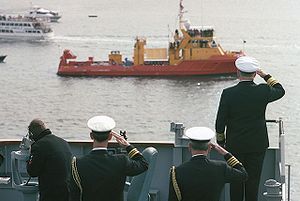HMAS Protector (ASR 241)
 HMAS Protector in 1992 | |
| Career (Australia (RAN)) | |
|---|---|
| Builder: | Stirling Marine Services, WA |
| Christened: | 1984 as MV Blue Nebula |
| Acquired: | 18 October 1990 |
| Commissioned: | November 1990 |
| Decommissioned: | 1998 |
| Renamed: |
1990 (HMAS Protector) 1998 (Seahorse Horizon) |
| Homeport: | HMAS Creswell |
| Status: | Sold to Defence Maritime Services, active as training ship |
| General characteristics | |
| Displacement: | 670 tons full load |
| Length: | 42.7 metres (140 ft) |
| Beam: | 9.5 metres (31 ft) |
| Draught: | 3 metres (9.8 ft) |
| Propulsion: | 2 Detroit 12V-92TA diesels; 2,440 hp (1.82 MW) sustained; 2 Heimdal cp propellors |
| Speed: | 11.5 knots (21.3 km/h) |
| Range: | 10,000 nautical miles (19,000 km) at 11 knots (20 km/h) |
| Endurance: | 14 days |
| Complement: | 6 civilian or 9 navy (for training) |
| Sensors and processing systems: | Navigation Radar: JRC 310 I-band. Decca RM 970BT I-band. Sonar:Klein side scan. |
| Aviation facilities: | Helicopter platform (removed 1992) |
HMAS Protector (ASR 241) was a Royal Australian Navy (RAN) trials and submarine rescue ship.
Previously the MV Blue Nabilla operated by the National Safety Council of Australia, Protector was purchased by the RAN in 1990, fitted with a LIPS dynamic positioning system, two Remotely Operated Vehicles and a recompression chamber.
She supported the Collins-class submarine trials and acceptance process from 1992. On 10 June 1995, Protector was slightly damaged when a switchboard malfunction aboard HMAS Collins caused the submarine to ram the trials ship.[1]
The vessel also performed in the surveillance, training, and diving support roles.
During 1997, Protector undertook a brief and unsuccessful search for the remains of HMAS Sydney.[2]
While Protector was decommissioned in 1998 she was sold to the RAN's support craft contractor, Defence Maritime Services, and remains in use as a training ship operating out of HMAS Creswell under the name Seahorse Horizon.[3]
In 2002, Seahorse Horizon took part in Exercise Dugong, laying and recovering mines.[4]
References
- ↑ Yule, Peter; Woolner, Derek (2008) (Google Books). The Collins Class Submarine Story: Steel, Spies and Spin. Port Melbourne, VIC: Cambridge University Press. pp. 213–4. ISBN 9780521868945. OCLC 213111359. http://books.google.com/books?id=qZ-WlswoHFwC. Retrieved 1 May 2009.
- ↑ Joint Standing Committee on Foreign Affairs, Defence and Trade (JCFADT) (22 March 1999). Report on the Loss of HMAS Sydney. Canberra: The Parliament of the Commonwealth of Australia. p. 139. ISBN 0642258724. OCLC 42768622. http://www.aph.gov.au/house/committee/jfadt/sydney/Reportinx.htm. Retrieved 9 November 2009.
- ↑ Navy News 1 June 1998
- ↑ Navy News 2 September 2002
